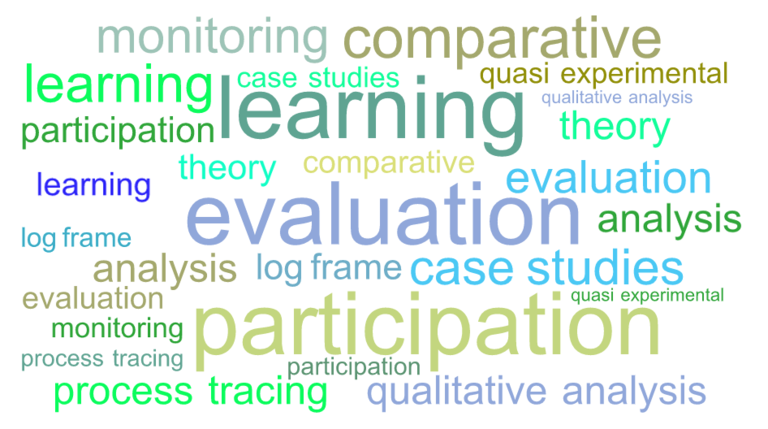Monitoring and evaluation, and impact evaluation methods
IIED's work in monitoring, evaluation and learning aims to provide the right type of information at the right time to the right people. Our goal is to learn about what works for whom, under what circumstances, how and why.

A word cloud with words relevant to monitoring, evaluation and learning (Image: IIED)
We have developed strategic capabilities in impact assessment, value for money and cost-benefit analysis, monitoring mechanisms, performance and process evaluation.
This set of skills and tools enables us to investigate transformational change in local-to-global systems. We are also considered a hub for South-South and South-North discourse thanks to our focus on systemic impact monitoring, evaluation and learning (MEL).
Social change usually results from a combination of multiple factors. These factors combine in complex ways to form "mechanisms" that describe and explain change under given circumstances. In order to account for and assess this level of complexity, we work with a set of robust MEL methodologies, and we are constantly trialling and testing innovative approaches to identify results, and unpack how change has come about, and for whom.
IIED has consistently proved to be progressive in using monitoring and evaluation to influence discourse, knowledge and processes of policymaking and governance by making these more evidence-based and inclusive.
Tracking Adaptation and Measuring Development (TAMD)
Tracking Adaptation and Measuring Development (TAMD) is a conceptual framework that can be used by countries to evaluate how far, and how well, climate risks are managed at international, national and sub-national levels.
It uses vulnerability and development indicators to assess whether development outcomes bring better local climate resilience, and contributes to climate-resilient development overall.
Social Assessment for Protected Areas (SAPA)
The approach to Social Assessment for Protected Areas (SAPA) is a rigorous mixed methods approach drawing on randomised sampling, household surveys, focus groups and participatory workshops.
It is a relatively simple, low cost methodology that managers of protected areas can use to make more informed and more equitable decisions regarding their impact on surrounding communities.
Process tracing
Process tracing with Bayesian updating, where Bayes' theorem is used to update the probability for a hypothesis as more evidence or information becomes available, is a case-based evaluation method. It uses both qualitative and quantitative approaches, and probative confidence updating, to assess the strength of confidence in the evidence for a specified story of change or causal mechanism.
Our research in Uganda shows that methods of process tracing and Bayesian updating facilitate a dialogue between theory and evidence that allows us to assess our degree of confidence in 'contribution claims' in a transparent and replicable way. Read a presentation on this evaluation on IIED's SlideShare site.
Social learning
The social learning approach provides a way to address complex problems by integrating diverse knowledge and value systems at many different levels and through different learning cycles.
It engages relevant stakeholders in co-framing challenges at community, regional, national and global scales with the aim of mobilising technical, institutional and social knowledge to unlock the potential that can accelerate change.
Participatory Learning and Action
Participatory approaches and tools facilitate people's involvement in decisions regarding issues that affect their lives by actively engaging them in decision-making processes. This fosters processes whereby people who may otherwise be disadvantaged and excluded gain voice, and access to and control over common resources.
IIED has an online archive that collects four decades of learning and experience documented in the Participatory Learning and Action (PLA) series.
Participatory mapping
Participatory mapping is an approach that enables communities to visualise and communicate their knowledge of their surrounding physical environment and how they are affected by it, knowledge often invisible to outsiders.
Through participatory mapping workshops, communities can map out in detail the resources they depend on, the qualities they attribute to these resources, who uses them, who depends on them and how they manage them.
Theory of change
A theory of change is a summary of the hypotheses that explain how and why planned activities will lead to expected results; that is, why what you do will work.
Outcome Harvesting
Outcome Harvesting is an evaluation approach in which outcome-level results are identified, formulated into outcome statements, relevant attribution is verified, and results are subsequently analysed and interpreted. It is particularly useful in contexts where relations of cause and effect are not fully understood.
Contact
Stefano D'Errico (stefano.derrico@iied.org), monitoring, evaluation, accountability and learning manager, Strategy and Learning Group



